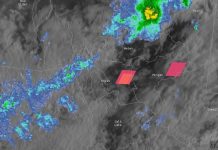
Why do strange sounds travel so far?
Why are strange sounds and mysterious booms so often heard over huge areas — sometimes 100 miles or more? Think of a seashell. When you hold it to your ear, you don’t hear the actual ocean; you hear ambient noise bouncing around and resonating inside the curved shell. The shell’s hard walls capture and redirect sound toward your ear.
Under the right weather conditions, the lower atmosphere behaves a lot like that shell. It can trap sound in a “channel”, guiding it across long distances with surprisingly little loss of intensity. That’s why a boom, blast or sky trumpet can be heard across multiple towns — even when nothing obvious is happening above you.
Weather affects sound propagation
The key player here is a temperature inversion. Normally, air gets colder as you go higher. But in calm, clear conditions — often at night or early morning — a layer of cool, dense air can sit near the ground with warmer air above it. This is called an inversion.
That inversion layer acts like the curved wall of a seashell or the ceiling of a tunnel. Sound waves hit it, bend, and reflect back down instead of escaping upward. Between the ground and the inversion, you get a natural sound channel or “waveguide,” and noise can travel for tens or even hundreds of kilometers with far less weakening than usual.
Explosions, mystery booms, industrial bangs, gunshots, sky trumpets — all of these can get sucked into this atmospheric duct and delivered to people far away who have no idea what’s actually making the noise.
👉 Also read: The Seneca Guns Mystery of North Carolina
How temperature inversions create a sound channel
A temperature inversion layer can be just a few meters thick or hundreds of meters deep. When its height and strength are “just right,” strange sounds and loud booms can bounce between the ground and the inversion over and over, losing only a little energy each time.
For someone standing 50 miles or more away, it can sound as if the source were only a few streets over. That’s why multiple counties sometimes report the same boom — all at slightly different times — even though radar, seismographs, and military bases show “nothing unusual.”
When the inversion breaks, the mystery vanishes
These calm, stable conditions are easiest to get on **quiet nights or early mornings**, often when there are no storms nearby. When the wind picks up, turbulence mixes the layers, breaking the inversion. Once that happens, sound spreads out in all directions, weakening quickly and becoming much quieter.
That’s why on some days the world seems unnaturally loud — distant trains, traffic, explosions, or booms sound close and sharp — and on other days, everything feels muffled. The sound hasn’t changed. The atmospheric lens around you has.
🌐 Explore mysterious booms by year: Mystery Booms Hub
Why this matters for mystery booms and strange sounds
Many reports of mystery booms, Seneca Guns, and strange apocalyptic sky sounds
likely involve some combination of a distant source plus a favorable sound channel in the atmosphere. The boom might be a quarry blast, a distant thunderclap, a sonic boom, industrial noise, or something more exotic — but the reason you hear it so clearly across a wide area is often the temperature inversion above your head.
In other words: you may not be standing next to the apocalypse. The sky is just doing weird acoustic tricks.
FAQ: Sound, Weather and Strange Booms
Why can strange sounds be heard over 100 miles away?
Under certain conditions, a layer of cool, dense air near the ground sits beneath warmer air above, creating a temperature inversion. This forms a natural sound channel that bends and reflects noise back toward the surface, allowing strange sounds and booms to travel much farther than usual with relatively little loss of intensity.
What is a temperature inversion and how does it affect sound?
A temperature inversion occurs when air near the ground is cooler than the air above it. This is the reverse of normal conditions. When this happens, sound waves tend to be refracted back downward instead of dispersing upward, effectively trapping them and allowing them to carry over long distances, especially in calm, stable weather.
Why do mystery booms seem louder on calm, clear days?
Calm, clear days and nights are ideal for forming temperature inversions. With little wind and strong cooling at the surface, the atmosphere becomes layered and stable. Sound then travels efficiently within those layers, so distant booms and bangs can sound surprisingly loud, even when the source is far away and invisible.
Does this explain all strange sounds and loud booms?
No. Sound propagation is only part of the story. The mechanism described here explains how sound can travel so far, not necessarily what the original source is. Mystery booms can still come from meteors, explosions, military activity, earthquakes, or unknown processes — but temperature inversions help explain why so many people, across such a wide area, hear them at once.
Is it dangerous when sound travels this way?
The sound channel itself is not dangerous — it’s just a quirk of atmospheric physics. However, the underlying source of the noise (explosions, severe storms, etc.) may carry its own risks. The inversion simply lets more distant observers eavesdrop on the chaos.













Sorry, don’t buy it. They are doing something either nearby or underground.
[…] on the weather condition, the explosion noises will be heard over several miles – up to 50 – around. You may also feel rumbles as if an earthquake was […]
[…] The jets could have been flying fast enough to generate sonic booms, which is possibly what island residents were experiencing as under the right atmospheric conditions sonic booms can carry very long distances. […]
[…] don’t be too surprised hearing strange sounds and explosive booms the next two days if you live in a 50 miles radius from the […]
[…] their guns offshore might have produced some of the booms. Under certain atmospheric conditions, sounds can travel farther than usual so that they might be heard onshore as loud booms. Naval firing might explain some of the Seneca […]
[…] Some inhabitants hear often in Moore an unforgettable loud ringing that stops suddenly and get the dogs riled up. This loud noise was not associated with ground motions, but the sound could have traveled from somewhere else. […]